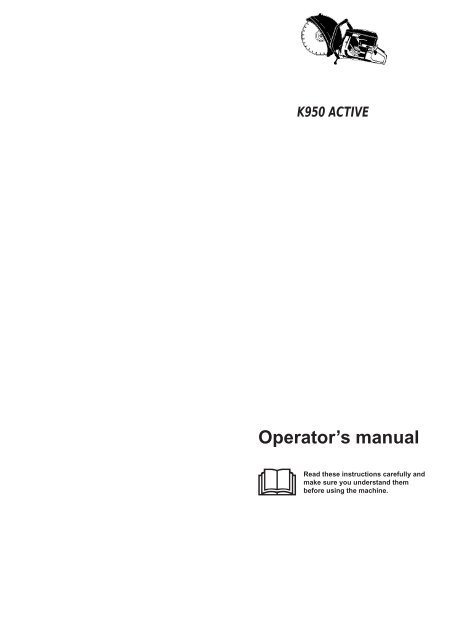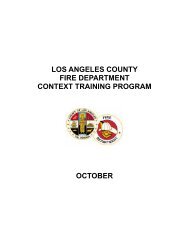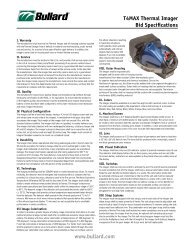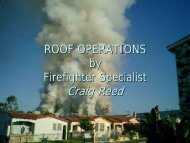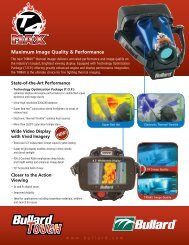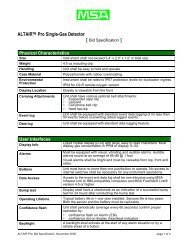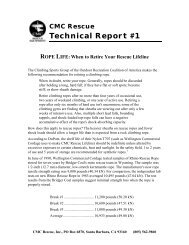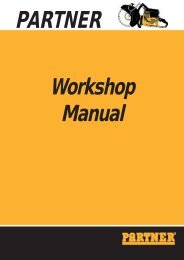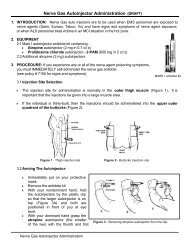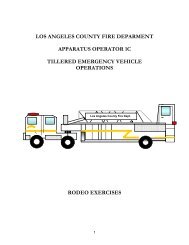PARTNER K950 Operators Manual 1998.pdf
PARTNER K950 Operators Manual 1998.pdf
PARTNER K950 Operators Manual 1998.pdf
Create successful ePaper yourself
Turn your PDF publications into a flip-book with our unique Google optimized e-Paper software.
<strong>K950</strong> ACTIVE<br />
Operator’s manual<br />
Read these instructions carefully and<br />
make sure you understand them<br />
before using the machine.
Symbols on the power cutter:<br />
SYMBOL EXPLANATION<br />
Symbols in the Operator's <strong>Manual</strong>:<br />
WARNING! The power cutter can be<br />
dangerous! Careless and incorrect use can<br />
result in serious or fatal injury to the<br />
operator or others.<br />
Switch off the engine by moving the stop<br />
switch to the STOP position before carrying<br />
out any checks or maintenance.<br />
Please read the instructions carefully and<br />
make sure you understand them before<br />
using the power cutter.<br />
Always wear approved protective gloves.<br />
Always wear:<br />
• Approved protective helmet<br />
• Approved hearing protection<br />
• Protective glasses or visor<br />
Regular cleaning is required.<br />
Warning<br />
Cutting creates a lots of dust which can<br />
cause inhalation damages. Use appropriate<br />
dust mask or respirator protection. Avoid<br />
breathing petrol fumes and exhaust gases.<br />
Provide for good ventilation.<br />
Visual check.<br />
Warning<br />
Sparks from the cutting blade can cause<br />
fire in combustible materials such as: petrol<br />
(gas), wood, dry grass etc.<br />
Protective glasses or a visor must be worn.<br />
2 – English
Before using your new Power cutter<br />
• Read the Operator’s <strong>Manual</strong> carefully.<br />
• Check the assembly and adjustment of the cutting blade, see<br />
chapter ”Assembly”.<br />
• Start the engine and check the carburettor settings. See<br />
chapter ”Maintenance”, section ”Carburettor”. When adjusted<br />
correctly the cutting blade should not rotate when idling.<br />
Setting the idling speed is described in the Operator’s<br />
<strong>Manual</strong>. Adjust the speed according to these instructions. Do<br />
not use the power cutter if the idling speed is not correctly<br />
adjusted!<br />
• Let your Partner dealer check the power cutter and carry out<br />
essential adjustments and repairs.<br />
!<br />
!<br />
WARNING!<br />
Under no circumstances should you modify<br />
the original design of the power cutter without<br />
approval from the manufacturer. Always use<br />
genuine spare parts. Unauthorized<br />
modifications or accessories may lead to<br />
serious injury or death.<br />
WARNING!<br />
Use of products which cut, grind, drill, sand or<br />
shape material can generate dust and vapors<br />
which may contain harmful chemicals. Know<br />
the nature of the material being worked on<br />
and wear appropriate dust mask or respirator<br />
protection.<br />
CONTENTS<br />
List of Contents<br />
Symbol explanation ..................................................... 2<br />
Safety instructions<br />
Personal protective equipment ....................................... 4<br />
The power cutter’s safety equipment ...................... 4<br />
Control, maintenance and service of the machine‘s safety<br />
equipment ............................................................................ 4<br />
General safety instructions .............................................. 6<br />
Transport and storage ......................................................... 6<br />
Fuel safety ........................................................................... 7<br />
General working instructions ........................................... 7<br />
Cutting ................................................................................. 7<br />
Kickback .............................................................................. 8<br />
Care and storage ................................................................. 9<br />
Cutting blades .................................................................... 10<br />
General .............................................................................. 10<br />
Abrasive blades ................................................................. 10<br />
Diamond blades ................................................................ 11<br />
What is what?<br />
What is what on a power cutter? ....................................... 12<br />
Assembly<br />
Fitting the cutting head ...................................................... 13<br />
Checking the drive shaft and flanges ................................ 13<br />
Fitting the cutting blade ..................................................... 13<br />
Fuel handling<br />
Fuel mixture ....................................................................... 14<br />
Fuelling .............................................................................. 14<br />
Start and stop<br />
Start and stop .................................................................... 15<br />
Maintenance<br />
Adjusting the drive belt ...................................................... 16<br />
Changing the drive belt ..................................................... 16<br />
Carburettor ........................................................................ 17<br />
Fuel filter ............................................................................ 18<br />
Air filter .............................................................................. 18<br />
Starter ................................................................................ 19<br />
Spark plug ......................................................................... 20<br />
Muffler................................................................................ 20<br />
Cooling system .................................................................. 20<br />
Daily maintenance ............................................................. 21<br />
Weekly maintenance ......................................................... 21<br />
Monthly maintenance ........................................................ 21<br />
Technical Data<br />
<strong>K950</strong> Active ....................................................................... 22<br />
English – 3
!<br />
!<br />
WARNING! Incorrect or careless use of a<br />
power cutter can turn it into a dangerous tool<br />
that can cause serious or even fatal injury. It<br />
is extremely important that you read and<br />
understand this manual.<br />
PERSONAL PROTECTIVE EQUIPMENT<br />
WARNING! When using a power cutter,<br />
protective equipment approved by the<br />
appropriate authorities must be used. Personal<br />
protective equipment does not eliminate<br />
the risk of accidents, however, it can reduce<br />
the effects of an injury in the event of an<br />
accident. Ask your dealer for help when<br />
choosing protective equipment.<br />
• PROTECTIVE HELMET<br />
• EAR PROTECTION<br />
• PROTECTIVE GLASSES<br />
OR FULL FACE<br />
PROTECTION<br />
• BREATHING MASK<br />
SAFETY INSTRUCTIONS<br />
THE POWER CUTTER’S SAFETY<br />
EQUIPMENT<br />
This section describes the power cutter’s safety equipment, its<br />
function and how checks and maintenance are carried out to<br />
ensure that it operates correctly. (See the chapter “What is<br />
what“ to locate where this equipment is positioned on your<br />
power cutter.)<br />
!<br />
1 Anti-vibration<br />
system<br />
WARNING! Never use a power cutter with<br />
defective safety equipment. Follow the<br />
control, maintenance and service instructions<br />
described in this manual.<br />
Your power cutter is equipped<br />
with an anti-vibration system.<br />
This is designed to give as low<br />
vibration levels and<br />
comfortable usage as possible.<br />
• HEAVY-DUTY, FIRM GRIP<br />
PROTECTIVE GLOVES<br />
• SNUG-FITTING, HEAVY-<br />
DUTY, COMFORTABLE<br />
CLOTHING THAT ALLOWS<br />
FULL FREEDOM OF<br />
MOVEMENT<br />
The power cutter’s antivibration<br />
system reduces the<br />
transfer of vibration between<br />
the engine/cutting equipment<br />
and the operator. The engine<br />
body including the cutting<br />
equipment is suspended in a<br />
handle system via antivibration<br />
elements.<br />
• LEG PROTECTION (TO<br />
PROTECT AGAINST<br />
SPARKS AND CUTTING<br />
FRAGMENTS)<br />
• ANTI-SLIP BOOTS WITH<br />
STEEL TOE CAPS<br />
2 Stop switch<br />
The stop switch should be<br />
used to stop the engine.<br />
• FIRST AID KIT SHOULD<br />
ALWAYS BE ON HAND<br />
4 – English
SAFETY INSTRUCTIONS<br />
3 Muffler<br />
!<br />
WARNING!<br />
During use and for some time<br />
after the muffler is very hot. Do not touch the<br />
muffler if it is hot!<br />
The muffler is designed to<br />
give the lowest possible noise<br />
level and to direct the engine‘s<br />
exhaust fumes away from the<br />
user. The engine‘s exhaust<br />
fumes are hot and can contain<br />
sparks, which can lead to the<br />
outbreak of fire.<br />
Control, maintenance and service of<br />
the machine‘s safety equipment<br />
!<br />
WARNING! All service and repairs to the<br />
power cutter require special training. This<br />
applies especially to the power cutter’s safety<br />
equipment. If the power cutter does not meet<br />
any of the controls listed below you should<br />
contact your service workshop.<br />
The purchase of one of our products<br />
guarantees that professional repair and<br />
servicing will be carried out on it. If the point<br />
of purchase is not one of our servicing<br />
dealers, please ask for details of the closest<br />
service workshop.<br />
1 Anti-vibration system<br />
Check the anti-vibration<br />
elements regularly for material<br />
cracks and deformation.<br />
IMPORTANT INFORMATION! It is extremely important that<br />
the instructions for checking, maintaining and servicing<br />
the muffler are followed. (see the section “Control,<br />
maintenance and service of the power cutter’s safety<br />
equipment“).<br />
4 Blade guard for the cutting blade<br />
!<br />
WARNING! Always check that the blade guard<br />
is correctly fitted before starting the machine.<br />
The blade guard is mounted<br />
above the cutting blade and<br />
prevents cutting fragments<br />
from being thrown towards the<br />
user.<br />
Check that the anti-vibration<br />
elements are securely<br />
mounted between the engine<br />
unit and the handle system.<br />
2 Stop switch<br />
Start the engine and make<br />
sure that the engine stops<br />
when the stop switch is<br />
moved to the stop position.<br />
English – 5
3 Muffler<br />
Never use a machine that<br />
has a defective muffler.<br />
Check regularly that the<br />
muffler is secured to the<br />
engine body.<br />
SAFETY INSTRUCTIONS<br />
GENERAL SAFETY INSTRUCTIONS<br />
IMPORTANT INFORMATION!<br />
Do not use the power cutter until you have read the<br />
entire contents of this Operator’s <strong>Manual</strong>.<br />
All servicing, in addition to the points listed in the<br />
section ”Control, maintenance and service of the<br />
power cutter’s safety equipment”, should be carried<br />
out by trained service specialists.<br />
• Use the equipment recommended in the chapter ”Personal<br />
safety equipment”.<br />
• Never use the machine when you are tired, under the<br />
influence of medicines/drugs or alcohol.<br />
• Do not lend the power cutter to anyone without providing this<br />
Operator’s <strong>Manual</strong>. Ensure the person using the power cutter<br />
understands the information in this Operator’s <strong>Manual</strong>.<br />
Transport and storage<br />
• Store the power cutter under lock and key so that it’s out of<br />
reach for children and unauthorised persons.<br />
• Do not store or transport the power cutter with the cutting<br />
blade fitted.<br />
4 Blade guard for the cutting blade<br />
Never use a defective blade<br />
guard or a blade guard that is<br />
not fitted correctly.<br />
!<br />
!<br />
WARNING! Check that the cutting blade is<br />
fitted correctly and does not show signs of<br />
damage. A damaged cutting blade can cause<br />
personal injury.<br />
WARNING! Never use a power cutter with<br />
defective safety equipment. The power<br />
cutter’s safety equipment should be checked<br />
and maintained as described in this<br />
Operator’s <strong>Manual</strong>. If your power cutter does<br />
not meet any of these controls you should<br />
contact your service workshop.<br />
6 – English
Fuel safety<br />
(Filling/Fuel mixture/Storage)<br />
!<br />
WARNING! Exercise great care when handling<br />
fuel. Bear in mind the risk of fire, explosions<br />
and inhaling fumes.<br />
SAFETY INSTRUCTIONS<br />
GENERAL WORKING INSTRUCTIONS<br />
This section takes up the basic safety precautions for working<br />
with the power cutter. Follow these general working instructions,<br />
but never use a machine without the possibility of calling for<br />
help in the event of an accident.<br />
Basic safety precautions<br />
• Never fill the machine while<br />
the engine is running.<br />
• Provide good ventilation<br />
when filling or mixing fuel<br />
(gasoline and 2-stroke oil).<br />
• Move the machine at least 3<br />
m from the filling position<br />
before starting.<br />
• Never start the machine:<br />
a) If you have spilt fuel<br />
on it. Wipe up all<br />
spillage.<br />
b) If you have spilt fuel<br />
on yourself or your<br />
clothes. Change your<br />
clothes.<br />
c) If there is a fuel leak.<br />
Make regular checks for<br />
leakage from the fuel<br />
cap and the fuel supply<br />
pipes.<br />
• Store the power cutter and fuel so that any leakage or fumes<br />
do not risk coming into contact with sparks or naked flames.<br />
For example, electric machines, electric motors, electrical<br />
switches/power switches, heaters or the like.<br />
• When storing fuel, approved containers intended for this<br />
purpose must be used.<br />
• When storing the power cutter for long periods the fuel tank<br />
must be emptied. Contact your local fuel station to find out<br />
how to dispose of excess fuel.<br />
• Use a Partner fuel can with an anti-spill device.<br />
Min 3 m<br />
(10ft)<br />
IMPORTANT INFORMATION! Never work with a power<br />
cutter that is defective or incorrectly adjusted. Do not<br />
work with a power cutter that is incomplete or where<br />
assembly has not been carried out in a satisfactory<br />
manner. Check that the cutting blade stops rotating<br />
when the throttle is released. If you encounter a situation<br />
where you are uncertain how to proceed you should ask<br />
an expert.<br />
Avoid all usage which you consider to be beyond your<br />
capability.<br />
• Check that no one is in the immediate vicinity when the<br />
machine is started or while working with the machine to<br />
ensure that people, animals or other things cannot affect your<br />
control of the power cutter.<br />
• Avoid usage in unfavourable weather conditions, for example,<br />
thick fog, heavy rain, strong winds or extreme cold, etc. To<br />
work in bad weather conditions is tiring and can create<br />
dangerous circumstances, e.g. slippery surfaces.<br />
• Never start to work with the power cutter before the working<br />
area is clear and you have a firm foothold. Look out for any<br />
obstacles with unexpected movement. Ensure when cutting<br />
that no material can become loose and fall, causing operating<br />
injury.Take great care when working on sloping ground.<br />
• Make sure clothing and parts of the body do not come into<br />
contact with the cutting blade when the engine is started.<br />
• Maintain a safe distance from the cutting blade when the<br />
engine is running.<br />
• The blade guard should always be fitted when the engine is<br />
running.<br />
• Ensure that the working area is sufficiently illuminated to<br />
create a safe working environment.<br />
• Some working positions may create greater stress on the<br />
operator.<br />
• Check the cutting area for buried cables and wires.<br />
!<br />
WARNING! Use a Partner fuel can with an<br />
anti-spill device. Fuel and fuel fumes are<br />
highly flammable. Think of the risks of fire,<br />
explosion and breathing in fumes. Stop the<br />
engine before refuelling. Do not overfill with<br />
fuel. Mop up any spills on the ground or the<br />
machine. If you spill fuel on yourself or your<br />
clothes, change your clothes. Move the<br />
machine at least 3 metres from the refuelling<br />
site before starting.<br />
!<br />
Only use the machine in areas with good<br />
ventilation. Neglect can result in serious<br />
injury or death.<br />
Cutting<br />
!<br />
WARNING! A safe distance from the power<br />
cutter is 15 metres. You are responsible that<br />
animals and onlookers are not in the working<br />
area. Do not start to work with the power<br />
cutter before the working area is clear and<br />
you have a firm foothold.<br />
• Start cutting with the engine at full throttle.<br />
• Always hold the power cutter firmly, with both hands. Hold<br />
the machine so that the thumb and fingers grip around the<br />
handle.<br />
English – 7
!<br />
Over<br />
exposure to vibrations can result in<br />
blood-vessel or nerve injury to persons<br />
suffering with blood circulation problems.<br />
Seek medical attention if you experience<br />
physical symptoms that can be related to over<br />
exposure to vibrations. Examples of such<br />
symptoms are numbness, lack of feeling,<br />
“tickling“, “pricking“, pain lack of or a<br />
reduction in normal strength, changes in the<br />
colour of the skin or its surfaces. These<br />
symptoms normally appear in the fingers,<br />
hands or wrists.<br />
SAFETY INSTRUCTIONS<br />
Water cooling<br />
!<br />
WARNING! Water cooling, which is only used<br />
for petrol-driven power cutters and when<br />
cutting concrete, cools the cutting blade and<br />
increases its service life as well as reduce<br />
dust formation (see the section ”Abrasive<br />
blades”). Among the disadvantages are<br />
difficulties at very low temperatures, the risk<br />
of damaging the floor and other sections of<br />
the building and risk for slippage.<br />
Cutting technique<br />
The technique described below is of a general character. Check<br />
information for each blade regarding individual cutting characteristics.<br />
(For example, a diamond blade requires less feeding<br />
pressure than a abrasive blade).<br />
1.Support the work piece<br />
in such away that you<br />
can predict what will<br />
happen and so it will not<br />
pinch.<br />
2.Always cut at full throttle.<br />
3.Start cutting gently, do<br />
not force or squeeze the<br />
blade in.<br />
4.Use a high blade speed.<br />
5.Move the blade slowly<br />
backwards and forwards.<br />
6.Use a small part of the<br />
blade’s cutting edge.<br />
7.Only use the blade’s<br />
cutting edge when<br />
cutting.<br />
8.Cut with the blade fully<br />
vertical – at right angles<br />
to the work piece.<br />
Sharpening diamond blades<br />
Blades can become dull when the wrong feeding pressure is<br />
used or when cutting some materials such as heavily reinforced<br />
concrete. To force a dull blade results in overheating and finally<br />
the loss of segments (part of the blade).<br />
Sharpen against a soft material such as sandstone, silica or<br />
haydite brick.<br />
Blade vibration<br />
The blade can become out of shape (not round) and vibrate if a<br />
too high feeding pressure is used or if the blade is pressed into<br />
the work piece.<br />
A lower feeding pressure ought to stop the vibration. Otherwise<br />
replace the cutting blade.<br />
Kickback<br />
Kickback can occur very suddenly and with great force. If the<br />
following directives are not followed, it can result in serious or<br />
even fatal injury.<br />
If the sector of the blade illustrated below is used for cutting the<br />
blade can start to climbing and kickback the power cutter<br />
upwards and backwards towards the user with immense force.<br />
How to avoid kickback<br />
1.Never cut with the<br />
segment illustrated in the<br />
diagram.<br />
2.Keep a good balance and<br />
a firm foothold.<br />
!<br />
!<br />
WARNING!<br />
Under all circumstances avoid cutting using<br />
the side of the blade; it will almost certainly<br />
be damaged, break and can cause immense<br />
damage. Only use the cutting section.<br />
WARNING!<br />
Do not lean the blade to the side, this can<br />
cause the blade to jam or break with personal<br />
injury as a consequence.<br />
3.Use both hands and take<br />
a firm grip with the thumb<br />
and fingers around the<br />
handle.<br />
4.Keep the work piece at a<br />
comfortable distance.<br />
5.Use the cutter at full<br />
throttle.<br />
6.Take care when inserting<br />
the blade in an existing<br />
cut.<br />
7.Never cut above shoulder<br />
height.<br />
8.Be alert to movement of<br />
the work piece or anything<br />
else that can occur, which<br />
could cause the cut to<br />
close and pinch the blade.<br />
8 – English
Pull in<br />
Pull in occurs when the lower part of the blade is suddenly<br />
stopped or when the cut closes. (To avoid this see the section<br />
”How to avoid kickback” and ”Pinching/rotation” below).<br />
Pinching/rotation<br />
Pinching occurs when the cut closes. The power cutter can be<br />
drawn suddenly and powerfully downwards.<br />
SAFETY INSTRUCTIONS<br />
Care and storage<br />
General<br />
Partner’s power cutters are robust and durable. However, as<br />
they are used for high speed operations all servicing should be<br />
carried out on time and as specified, so that the power cutter<br />
always works effectively and safely.<br />
How to avoid pinching<br />
Support the work piece in<br />
such a way that the cut<br />
remains open during the<br />
cutting operation and when<br />
the cut is finished.<br />
Drying the blade<br />
After using the blade with<br />
water cooling, let the cutter<br />
run for approx. half a minute<br />
so that the blade dries.<br />
If a damp blade is stored it<br />
can become unbalance and<br />
cause damage.<br />
Check the speed of the<br />
drive shaft<br />
Use a tachometer regularly to<br />
check the speed of the drive<br />
shaft when the cutter is<br />
running at working temperature<br />
and at full throttle without<br />
a load. The maximum speed<br />
is stated on the unit.<br />
Read this Operator’s <strong>Manual</strong> to determine which service<br />
routines you can carry out and ensure that all other service<br />
work is carried out by an authorised service workshop.<br />
Power Cutter<br />
Always handle the power cutter with care and store it with the<br />
blade removed.<br />
Blades<br />
• All blades should be<br />
removed from the cutter<br />
after use and stored<br />
carefully.<br />
• Special care should be<br />
taken with abrasive<br />
blades.<br />
• Blades must be stored on<br />
a firm, level surface. If<br />
blades are supplied with a<br />
backing pad then a spacer<br />
should be used to keep<br />
them flat.<br />
• Avoid moisture and<br />
temperature extremes.<br />
• Remove the blades before<br />
the cutter is moved or<br />
transported.<br />
• Inspect new blades for<br />
transport or storage<br />
damage.<br />
!<br />
WARNING!<br />
If the speed is higher than that stated then the<br />
unit must be adjusted by an authorised<br />
service workshop before it is used.<br />
English – 9
CUTTING BLADES<br />
SAFETY INSTRUCTIONS<br />
Abrasive blades<br />
The cutting material in an abrasive blade consists of abrasive<br />
corn that is held together by an organic bonding agent.<br />
”Reinforced blades” are made up of a fabric or fibre base that<br />
prevents total breakage at maximum working speed if the blade<br />
should be cracked or damaged. (The term reinforced does not<br />
refer to those cutting blades that are only reinforced around the<br />
flange).<br />
A cutting blade’s performance is determined by the type and<br />
size of abrasive corn, and the type and hardness of the bonding<br />
agent.<br />
Characteristics that give the blade a shorter service life and<br />
greater cutting capacity are said to make the blade ”softer”. A<br />
blade with a longer service life and slower cutting capacity is a<br />
blade with a ”harder” effect.<br />
General<br />
Cutting blades are available in two standard designs; abrasive<br />
blades and diamond blades.<br />
High quality cutting blades are normally more economical.<br />
Lower quality cutting blades usually have an inferior cutting<br />
capacity and shorter service life, which results in higher cost per<br />
processed material.<br />
ABRASIVE BLADES, TYPES AND USES<br />
!<br />
WARNING!<br />
A cutting blade may burst and cause injury<br />
to the operator.<br />
Blade<br />
type<br />
General<br />
characteristics<br />
Use<br />
Material<br />
Water cooling<br />
High speed portable tools<br />
Cutting blades of the make Partner are manufactured for<br />
portable, high speed, power cutters. If other makes of cutting<br />
blades are used, ensure the blades comply with all the<br />
directives and requirements attributed to the specific type of<br />
power cutter.<br />
!<br />
WARNING!<br />
Never exceed the maximum working speed of<br />
a cutting blade.<br />
Special blades<br />
Some cutting blades are designed for stationary equipment and<br />
for use with attachments. These types of cutting blades must<br />
not be used on portable, power cutters.<br />
Concrete<br />
Metal<br />
Universal<br />
usage,<br />
economical<br />
Unbeatable for<br />
steel (not<br />
suitable for<br />
concrete, etc.)<br />
Concrete,<br />
asphalt,<br />
stone,<br />
brickwork,<br />
cast iron,<br />
aluminium,<br />
copper,<br />
brass, cables,<br />
rubber, etc.<br />
Steel, steel<br />
alloys and<br />
other hard<br />
metals.<br />
Increases the<br />
blade’s service<br />
life. Reduces<br />
dust formation.<br />
Recommended.<br />
Reduces cutting<br />
capacity NOT<br />
recommended.<br />
!<br />
WARNING!<br />
Never use a cutting blade for any other<br />
purpose than that it was intended for.<br />
Always contact local authorities and make sure you are<br />
following applicable directives.<br />
10 – English
Type of cutting blades<br />
Check that the blade is<br />
approved for the same or<br />
higher speed according to the<br />
aproval plate of the engine.<br />
Do not exceed the maximum<br />
working speed stated on the<br />
blade.<br />
Damage<br />
• Ensure the blade it not<br />
cracked or damaged in any<br />
other way.<br />
• Test the blade by hitting it<br />
gently with a piece of wood.<br />
If the blade does not give a<br />
full-sounding ring then it is<br />
damaged.<br />
• Never use a blade that has<br />
fallen on the floor.<br />
Assembly<br />
• Check that the blade is<br />
fitted correctly and is<br />
secure.<br />
• Follow all specifications in<br />
the table below.<br />
SAFETY INSTRUCTIONS<br />
100 m/s<br />
6300 rpm<br />
Guard<br />
Check that the guard is not<br />
cracked or shows signs of any<br />
other damage. Clean the<br />
inside of the guard before<br />
fitting a new blade. Check that<br />
the guard can be adjusted.<br />
Diamond blades<br />
Diamond blades are basically made in the same way as<br />
abrasive blades but are manufactured from industrial diamonds<br />
held together by a bonding agent.<br />
DIAMOND BLADES, TYPES AND USES<br />
Diamond General char- Material Water cooling<br />
blade acteristics<br />
Low cost per<br />
cutting operation.<br />
Less blade<br />
changes.<br />
Constant cutting<br />
depth. Less<br />
dust.<br />
All brickwork,<br />
reinforced<br />
concrete and<br />
other<br />
composite<br />
materials.<br />
NOT<br />
recommended<br />
for metal.<br />
Increases the<br />
blades service<br />
life.<br />
Specifications for fitting blades<br />
Standard blades inches .787 7/8 1<br />
centre hole (spindle) mm 20 22,2 25,4<br />
Reducing bush* Max. thickness Blade thickness<br />
Min thickness 3 mm (1/8")<br />
Backing pad Material Highly compressible,<br />
(Must be used)<br />
e.g. blotting paper<br />
Max. thickness 0,5 mm (.020")<br />
Spindle hole/ Play 0,2 mm (.010")<br />
drive shaft<br />
!<br />
WARNING!<br />
Cool a diamond blade continously with water<br />
to prevent overheating, which can cause the<br />
blade to break and pieces being thrown off<br />
resulting in injury and damage.<br />
Using diamond blades<br />
Proceed as follows:<br />
• Let the blade rotate in the same direction as the arrow<br />
indicates.<br />
• Cool continually with water.<br />
• Keep the blade sharp.<br />
• Remove the blade when transporting the cutter.<br />
Avoid:<br />
• Running the blade in the wrong direction.<br />
Flange tightening<br />
Blade/guard<br />
The blade does not slip, flange not bent<br />
Check that the blade runs free of the<br />
guard.<br />
• Forcing a dull blade or wedging the blade into a cut.<br />
• Transporting the cutter with the blade fitted.<br />
• Letting the blade fall on the work piece.<br />
* Plastic reducing bushes may only be used with abrasive<br />
blades. Do not use reducing bushes with diamond blades or<br />
tungsten carbide tipped blades. We recommend that the<br />
spindle is replaced so that it fits the blades to be used rather<br />
than using a reducing bush. Contact your service workshop<br />
for details.<br />
Dry diamond blades<br />
Dry diamond blades are a new generation of blades that do not<br />
require water cooling. However, the blades are still damaged by<br />
excessive heat. It is good economics to let the blade cool by<br />
simply lifting the blade from the cut every 30–60 seconds and<br />
let it rotate in the air, for 10 seconds to cool.<br />
English – 11
WHAT IS WHAT?<br />
19<br />
14<br />
1<br />
5<br />
2<br />
15<br />
18<br />
21<br />
20<br />
16<br />
3<br />
7<br />
6<br />
4<br />
12 10<br />
9<br />
8<br />
11<br />
17<br />
13<br />
What is what on a power cutter?<br />
1. Cylinder cover<br />
2. Muffler<br />
3. Fuel tank<br />
4. Starter throttle catch<br />
5. Choke<br />
6. Throttle trigger lockout<br />
7. Stop switch<br />
8. Cutting head<br />
9. Cutting arm<br />
10. Belt tensioning screw<br />
11. Cutting blade<br />
12. Throttle control<br />
13. Combination spanner<br />
14. Air filter cover<br />
15. Blade guard<br />
16. Starter handle<br />
17. Operator’s manual<br />
18. Adjustment handle for blade guard<br />
19. Front handle<br />
20. Starter<br />
21. Decompression valve<br />
12 – English
ASSEMBLY<br />
Fitting the cutting head<br />
Fitting the cutting blade<br />
Remove the bolts (1). Remove<br />
the cover. Fit the drive belt<br />
over the clutch drum. Refit the<br />
cover and tighten the bolts.<br />
Partner cutting blades are<br />
manufactured and approved<br />
for freehand cutting. The<br />
paper labels on each side of<br />
the blade are there to<br />
distribute the pressure from<br />
the flange washer and prevent<br />
the blade from slipping.<br />
1<br />
The blade is placed between<br />
the flange hub (A) and the<br />
flange washer (B). The flange<br />
washer is turned so that it fits<br />
in the flange hub. The cutting<br />
blade is tightened using the<br />
socket spanner 501 69 17-02.<br />
A<br />
B<br />
Feed the drive belt over the<br />
pulley on the cutting head (2).<br />
Slide on the belt cover and<br />
secure the cutting head<br />
together with the belt guard.<br />
Tighten both bolts (4) by hand.<br />
2<br />
The shaft can be locked using<br />
a screwdriver, steel pin or the<br />
like. This is slid in as far as<br />
possible. The blade is tightened<br />
clockwise.<br />
Tightening torque for the bolt<br />
holding the blade is:<br />
15-25 Nm (130-215 in.lb).<br />
Screw in the tensioning screw<br />
(3) so that the square nut is in<br />
line with the arrow on the belt<br />
guard. Shake the head to<br />
ensure the spring can tension<br />
the belt. This automatically<br />
adjusts the belt to the correct<br />
tension. Tighten both bolts (4)<br />
using the combination<br />
spanner.<br />
NOTE! After fitting a new belt<br />
the belt tension must be<br />
readjusted after the first two<br />
tanks of fuel have been used.<br />
4 3<br />
Checking the drive shaft and flanges<br />
Blade guard<br />
The blade guard should<br />
always be fitted on the<br />
power cutter.<br />
The guard should be adjusted<br />
so that the rear section is<br />
close to the work piece.<br />
Cutting fragments and sparks<br />
are then collected by the<br />
guard and led away from the<br />
user.<br />
• Check that the threads on<br />
the drive shaft are<br />
undamaged.<br />
• Check that the contact<br />
surfaces of the cutting blade<br />
and flanges are flat, run<br />
correctly on the spindle and<br />
are free from foreign<br />
objects.<br />
!<br />
WARNING!<br />
16 inch blade and blade guard should only be<br />
used on power cutters originally equipped<br />
with a 16" blade guard. If a blade guard is<br />
fitted as a spare part on a power cutter<br />
originally equipped with a 14" blade guard, the<br />
16" cutting blade will rotate too fast. A cutting<br />
blade with too high speed can burst or cause<br />
serious injury and damage.<br />
Do not use flanges that are<br />
twisted, have damaged<br />
edges, untrue or dirty. Do<br />
not use different size<br />
flanges.<br />
English – 13
Fuelmix<br />
IMPORTANT! The power cutter is equipped with a two-stroke<br />
engine and must always been run using a mixture of petrol and<br />
two-stroke engine oil. It is important to accurately measure the<br />
amount of oil to be mixed to ensure that the correct mixture is<br />
obtained. When mixing small amounts of fuel, even small<br />
inaccuracies can drastically affect the ratio of the mixture.<br />
!<br />
Always provide for good ventilation when<br />
handling fuel.<br />
Petrol<br />
• Use good quality unleaded<br />
or leaded petrol.<br />
• The lowest octane<br />
recommended is 90.<br />
• If you run the engine on a<br />
lower octane grade than 90<br />
so-called, knocking can<br />
occur. This gives rise to a<br />
high engine temperature,<br />
which can result in serious<br />
engine damage.<br />
Two-stroke oil<br />
• For the best results use<br />
<strong>PARTNER</strong> two-stroke oil,<br />
which is especially<br />
developed for power<br />
cutters. Mixing ratio 1:50<br />
(2%).<br />
• If <strong>PARTNER</strong> two-stroke oil<br />
is not available, you may<br />
use another two-stroke oil of<br />
good quality that is intended<br />
for air cooled engines.<br />
Contact your dealer when<br />
selecting an oil. Mixing ratio<br />
1:33 (3%)-1:25 (4%).<br />
• Never use two-stroke oil<br />
intended for water cooled<br />
outboard engines, so-called,<br />
outboard oil.<br />
• Never use oil intended for<br />
four-stroke engines.<br />
Mixing<br />
• Always mix the petrol and<br />
oil in a clean container<br />
intended for fuel.<br />
• Always start by filling half<br />
the amount of the petrol to<br />
be used. Then add the<br />
entire amount of oil. Mix<br />
(shake) the fuel mixture.<br />
Add the remaining amount<br />
of petrol.<br />
• Mix (shake) the fuel mixture<br />
thoroughly before filling the<br />
saw’s fuel tank.<br />
• Do not mix more than max.<br />
one month’s supply of fuel.<br />
• If the power cutter is not<br />
used for some time the fuel<br />
tank should be emptied and<br />
cleaned.<br />
Gasolin<br />
Benzin<br />
Essence<br />
Gasolina<br />
Lit.<br />
5<br />
10<br />
15<br />
20<br />
US<br />
gallon<br />
1<br />
2 1/2<br />
5<br />
2%(1:50)<br />
0,10<br />
0,20<br />
0,30<br />
0,40<br />
2%(1:50)<br />
2 1/2<br />
6 1/2<br />
12 7/8<br />
FUEL HANDLING<br />
Oil • Öl<br />
Huile • Aceite<br />
Lit.<br />
3%(1:33)<br />
0,15<br />
0,30<br />
0,45<br />
0,60<br />
US<br />
fl. oz.<br />
3%(1:33)<br />
3 3/4<br />
9 3/4<br />
19 1/4<br />
4%(1:25)<br />
0,20<br />
0,40<br />
0,60<br />
0,80<br />
4%(1:25)<br />
5 1/8<br />
12 7/8<br />
25 3/4<br />
Fuelling<br />
!<br />
WARNING!The following precautions reduce<br />
the risk of fire:<br />
• Do not smoke or place any sources of heat in the<br />
vicinity of the fuel.<br />
• Never refuel when the engine is running.<br />
• Open the fuel cap slowly when fuelling so that any over<br />
pressure is released slowly.<br />
• Tighten the fuel cap carefully after refuelling.<br />
• Always move the machine from the fuelling place<br />
before starting.<br />
• Keep the handle dry, clean<br />
and free from oil and fuel.<br />
• Clean around the fuel cap.<br />
Clean the fuel tank<br />
regularly. The fuel filter<br />
should be changed at least<br />
once per year<br />
Contamination in the tank<br />
can disrupt operations.<br />
Ensure that the fuel is well<br />
mixed by shaking the<br />
container before filling the<br />
tank.<br />
• Always exercise care when<br />
filling the fuel. Move the<br />
power cutter at least three<br />
metres from the filling area<br />
before starting. Make sure<br />
the fuel cap is tightened.<br />
Min 3 m<br />
(10ft)<br />
14 – English
Start and stop<br />
!<br />
WARNING! Before starting observe the<br />
following:<br />
• Do not start the power cutter without the cutting arm or<br />
cutting head fitted. Otherwise the clutch can come<br />
loose and cause personal injury.<br />
• Always move the power cutter from the filling area<br />
before starting.<br />
• Ensure that you and the machine stand firmly and that<br />
the cutting blade rotates freely.<br />
• Make sure no unauthorised persons are within the<br />
working area.<br />
Starting a cold engine<br />
IGNITION:<br />
Slide the stop switch to the<br />
left.<br />
CHOKE:<br />
Pull out the choke.<br />
START AND STOP<br />
Start<br />
WARNING! The cutting blade can rotate when<br />
the engine starts. Make sure it can rotate<br />
! freely.<br />
Take hold of the front handle<br />
using your left hand. Place<br />
your right foot on the lower<br />
section of the rear handle and<br />
press the power cutter against<br />
the ground.<br />
Grip the starter with your right<br />
hand, and slowly pull the<br />
starter cord out until you feel<br />
some resistance (the pawls<br />
grip) now pull quickly and<br />
powerfully.<br />
NOTE! Do not pull out the<br />
starter cord completely and do<br />
not release the starter from<br />
the fully extended position.<br />
This can damage the power<br />
cutter.<br />
STARTER THROTTLE<br />
CATCH<br />
Press in the throttle control<br />
and thereafter the starter<br />
throttle catch (A). Release the<br />
throttle control and the throttle<br />
is blocked in half throttle<br />
position. The catch is released<br />
when the throttle control is<br />
pressed in all the way.<br />
A<br />
When the engine starts,<br />
quickly apply full throttle and<br />
the starter throttle catch will<br />
automatically disengage.<br />
DECOMPRESSION VALVE<br />
Press in the valve to reduce<br />
the pressure in the cylinder,<br />
this makes starting the power<br />
cutter easier. The<br />
decompression valve should<br />
always be used when starting.<br />
When the machine has<br />
started the valve automatically<br />
returns to its original position.<br />
Stop<br />
The engine is stopped by<br />
switching off the ignition.<br />
(Slide the stop switch to the<br />
right.)<br />
Starting a warm<br />
engine<br />
Use the same procedure as<br />
for starting cold engine but<br />
without choke. Fast idle is<br />
recived by first set the choke<br />
control in choke position, and<br />
then back again.<br />
English – 15
MAINTENANCE<br />
Adjusting the drive belt<br />
• The drive belt is fully<br />
enclosed and well protected<br />
from dust, dirt and<br />
mechanical effects during<br />
the cutting process.<br />
• To tension the drive belt,<br />
slightly loosen the bolts (A),<br />
which secure the cutting<br />
head and belt guard.<br />
• Turn the tensioning screw<br />
so that the nut (B) is located<br />
directly under the arrow on<br />
the cover. Shake the head<br />
to ensure the spring can<br />
tension the belt. The belt<br />
now automatically has the<br />
right tension.<br />
A<br />
Belt pulley and clutch<br />
Never start the engine when the belt pulley and clutch are<br />
removed for maintenance.<br />
• Tighten the bolts that hold<br />
the cutting head.<br />
B<br />
IMPORTANT INFORMATION! A new drive belt should be<br />
tensioned after using one or two tanks of fuel.<br />
Changing the drive belt<br />
• Loosen the two bolts (A).<br />
• Turn the tensioning<br />
screw(B) until the tension<br />
has been released.<br />
A<br />
• Remove the two bolts (A).<br />
• Remove the front belt cover<br />
(C).<br />
• Remove the belt from the<br />
pulley.<br />
• Dismantle the cutting head.<br />
• Remove the nut (D).<br />
Remove the side cover.<br />
• Replace the drive belt.<br />
• To assemble reverse the<br />
procedure for dismantling.<br />
B<br />
C<br />
• Check the blade guard for<br />
signs of cracking or other<br />
damage. Replace it if<br />
damaged.<br />
D<br />
!<br />
WARNING! Never use a power cutter without a<br />
blade guard over the cutting blade.<br />
16 – English
Carburettor<br />
Your Partner product has been designed and manufactured to<br />
specifications that reduce harmful emissions.<br />
After your unit has been run 8-10 tanks of fuel the engine has<br />
broken in. To ensure that your unit is at peak performance and<br />
producing the least amount of harmful emissions after break in,<br />
have your authorized servicing dealer, who has a revolution<br />
counter at his disposal, to check your carburettor for optimum<br />
operating conditions.<br />
Functioning, Final setting<br />
!<br />
WARNING! Do not start the power cutter<br />
without the cutting arm or cutting head fitted.<br />
Otherwise the clutch can come loose and<br />
cause personal injury.<br />
MAINTENANCE<br />
Operation<br />
• The carburettor governs the engine speed via the throttle. Air/<br />
fuel are mixed in the carburettor<br />
Jets<br />
The carburettor is equipped with fixed jets to ensure the engine<br />
always receives the correct fuel air mixture.<br />
If the engine lacks power or accelerates poorly do the following:<br />
• Inspect or, if necessary, replace the air filter.<br />
• If this does not help, contact an authorised service workshop.<br />
Final setting of the idling speed T<br />
Adjust the idling speed with the screw T. If it is necessary to readjust,<br />
first turn the idle speed adjusting screw T clockwise, until<br />
the blade starts to rotate. Then turn, counter-clockwise until the<br />
blade stops. A correctly adjusted idle speed setting occurs<br />
when the engine runs smoothly in every position. It should also<br />
be good margin to the rpm when the blade starts to rotate.<br />
Recommended idling speed: 2 500 rpm.<br />
!<br />
been<br />
Contact your servicing dealer, if the idle speed<br />
setting cannot be adjusted so that the blade<br />
stops. Do not use the power cutter until it has<br />
properly adjusted or repaired.<br />
T<br />
English – 17
Fuel filter<br />
• The fuel filter sits inside the fuel tank.<br />
• The fuel tank must be protected from contamination when<br />
filling. This reduces the risk of operating disturbances caused<br />
by blockage of the fuel filter.<br />
• The filter cannot be cleaned but must be replaced with a new<br />
filter when it blocked. The filter should be changed at least<br />
once per year.<br />
MAINTENANCE<br />
Air filter<br />
The air filter should be<br />
cleaned regularly removing<br />
dust and dirt to avoid:<br />
• Carburettor malfunction<br />
• Starting problems<br />
• Reduced engine power<br />
• Unnecessary wear to<br />
engine parts<br />
• Abnormal fuel consumption<br />
1<br />
2<br />
A<br />
B<br />
The air filter system consists<br />
of a main filter and a back-up<br />
filter:<br />
1)The main-filter is an oiled<br />
foam filter that is easily<br />
accessible under the filter<br />
cover A. When used in<br />
dusty conditions, this filter<br />
should be checked/<br />
replaced after every second<br />
tank of fuel. The filter must<br />
be cleaned and oiled<br />
regularly to obtain a<br />
satisfactory filtering effect.<br />
There is a special<br />
<strong>PARTNER</strong> oil produced for<br />
this purpose.<br />
• Remove the filter. Wash the<br />
filter carefully in tepid,<br />
soapy water. After cleaning<br />
rinse the filter thoroughly in<br />
clean water. Squeeze out<br />
the filter and let the filter<br />
dry. NOTE! Compressed air<br />
at a high pressure can<br />
damage the foam.<br />
• Oil the filter carefully. It is extremely important that the entire<br />
filter is saturated in oil.<br />
2)The back-up filter is a paper filter and is accessible from<br />
under cover B. This filter should be changed/cleaned when<br />
the engine’s output drops or after 1-2 weeks. The filter is<br />
cleaned by shaking or carefully using compressed air. Note<br />
the filter must not be washed!<br />
A filter used for a long period of time can never be completely<br />
cleaned. Therefore all air filters must be replaced periodically<br />
with a new filter. A damaged air filter must always be<br />
replaced.<br />
IMPORTANT INFORMATION!<br />
Insufficient care of the air filter will cause deposits on<br />
the spark plug resulting in abnormal wear to engine<br />
parts.<br />
18 – English
Starter<br />
MAINTENANCE<br />
Tensioning the recoil spring<br />
!<br />
WARNING!<br />
• The recoil spring sits in its tensioned position<br />
in the starter housing and can with<br />
careless handling fly out and cause personal<br />
injury.<br />
• When replacing the recoil spring or the<br />
starter cord great care should be exercised.<br />
Always wear protective glasses.<br />
Replacing a broken or worn starter cord<br />
• Lift up the starter cord from<br />
the cut out on the pulley and<br />
turn the pulley approx. 2<br />
turns clockwise.<br />
NOTE! Ensure the starter<br />
pulley can be turned at least<br />
a further 1/2 turn when the<br />
starter cord is fully<br />
extended.<br />
• Loosen the bolts that hold<br />
the starter against the<br />
crankcase and lift off the<br />
starter unit.<br />
Replacing a broken recoil spring<br />
• Lift the starter pulley (see<br />
"Changing a broken or worn<br />
starter cord").<br />
• Pull out the cord approx. 30<br />
cm and lift it out of the cutout<br />
in the starter-pulley’s<br />
periphery. Reset the recoil<br />
spring by allowing the pulley<br />
to slowly rotate backwards.<br />
• Loosen the screw in the<br />
centre of the starter-pulley<br />
and lift off the pulley. Insert<br />
and secure the starter cord<br />
in the starter pulley. Wind<br />
on approx. 3 turns of the<br />
cord on the pulley. Fit the<br />
pulley on the recoil spring<br />
so that the end of the recoil<br />
spring hooks on the pulley.<br />
Fit the screw in the centre of<br />
the pulley. Thread the<br />
starter cord through the hole<br />
in the starter housing and<br />
the starter handle. Tie a<br />
good knot on the end of the<br />
cord.<br />
• Loosen the screws holding<br />
the spring cassette.<br />
• Disassemble the recoil<br />
spring by tapping the pully<br />
(with its inside facing down)<br />
lightly against a working<br />
bench or similar. If the<br />
spring pops out when<br />
assembling, it should be<br />
mounted again, out and in<br />
towards the centre.<br />
• Lubricate the recoil spring<br />
with thin oil. Assemble the<br />
starter pulley, and tension<br />
the recoil spring.<br />
Fitting the starter<br />
• Fit the starter by first pulling<br />
out the starter cord and then<br />
placing the starter in<br />
position on the crankcase.<br />
No slowly release the<br />
starter cord so that the<br />
pawls grip in the pulley.<br />
• Fit and tighten the screws<br />
that hold the starter.<br />
English – 19
Spark plug<br />
The condition of the spark plug<br />
is affected by:<br />
• An incorrect carburettor<br />
setting.<br />
• An incorrect fuel mixture<br />
(too much oil).<br />
• A dirty air filter.<br />
These factors cause deposits<br />
on the spark plug electrode<br />
that may result in malfunction<br />
or starting difficulties.<br />
• If the machine is low on<br />
power, difficult to start or<br />
runs poorly while idling<br />
always check the spark<br />
plug first. If the spark plug<br />
is dirty, clean it and at the<br />
same time check that the<br />
electrode gap is 0,5 mm<br />
(.020"). The spark plug<br />
should be changed after<br />
about one month of<br />
operation or earlier if<br />
necessary.<br />
0,5 mm<br />
NOTE! Always use the recommended type of spark plug. (see<br />
chapter ”Technical data”)! An incorrect spark plug can damage<br />
the cylinder/piston.<br />
MAINTENANCE<br />
Cooling system<br />
To maintain as low an operating temperature as possible the<br />
power cutter is equipped with a cooling system.<br />
The cooling system consists<br />
of:<br />
1. An air intake on the<br />
starter unit.<br />
2. Air flow guide.<br />
3. Cooling fins on the<br />
flywheel.<br />
4. Cooling fins on the<br />
cylinder<br />
5. Cylinder cover (leads cold<br />
air onto the cylinder).<br />
Clean the cooling system<br />
using a brush at least once<br />
a week, in difficult<br />
conditions more often. A<br />
dirty or blocked cooling<br />
system leads to the engine<br />
overheating resulting in<br />
damage to the cylinder and<br />
piston.<br />
3<br />
4<br />
1<br />
5<br />
2<br />
Muffler<br />
The muffler is designed in<br />
order to reduce the noise level<br />
and to direct the exhaust<br />
gases away from the operator.<br />
The exhaust gases are<br />
hot and can contain sparks,<br />
which may cause fire if<br />
directed against dry and<br />
combustible material.<br />
Never use a saw with a<br />
clogged or defective muffler.<br />
20 – English
MAINTENANCE<br />
2<br />
5<br />
9<br />
4<br />
11<br />
15<br />
17<br />
1<br />
6<br />
20<br />
12<br />
18<br />
19<br />
8<br />
Below follows some general maintenance instructions.<br />
If you need further information please contact your service<br />
workshop.<br />
2<br />
Daily maintenance<br />
1. Check that throttle components work correctly from a safety<br />
view point (throttle and starter throttle catch).<br />
2. Clean the main filter.<br />
9<br />
13<br />
14<br />
3. Check the tension of the drive belt.<br />
4. Check the condition of the cutting blade.<br />
5. Check the condition of the blade blade.<br />
6. Check the starter and the starter cord; clean the outside of<br />
the starter’s air intake.<br />
7. Check that all nuts and bolts are tightened correctly.<br />
8. Check the function of the stop switch.<br />
7<br />
16 10 3 4<br />
Weekly maintenance<br />
9. Check the back-up paper filter.<br />
10. Check that the handles and the anti-vibration elements are<br />
not damaged.<br />
11. Clean the spark plug. Check that the electrode gap is 0.5<br />
mm.<br />
12. Clean the cooling fins on the flywheel. Check the starter<br />
and recoil spring.<br />
Monthly maintenance<br />
16. Check the clutch drum, drive-pulley, and clutch springs with<br />
regard to wear.<br />
17. Clean the outside of the carburettor<br />
18. Check the fuel filter, fuel hose, change if necessary.<br />
19. Clean the inside of the fuel tank.<br />
20. Check all cables and connections.<br />
13. Clean the cooling fins on the cylinder.<br />
14. Check the muffler.<br />
15. Check the carburettor function.<br />
English – 21
TECHNICAL DATA<br />
Engine<br />
Cylinder volume, cm 3/ cu.in 93,6/5,7<br />
Cylinder bore, mm/inch ∅ 56/2,2"<br />
Stroke, mm/inch 38/1,5"<br />
Idle speed, rpm<br />
2 500 rpm<br />
Recommended max. speed, unloaded, rpm 9 800 ± 300<br />
Power, kW 4,5<br />
Ignition system<br />
Manufacturer<br />
FHP<br />
Spark plug<br />
Champion RCJ-7Y<br />
Electrode gap, mm/inch 0,5 (.020")<br />
Fuel and lubrication system<br />
Manufacturer<br />
Tillotson<br />
Carburettor type<br />
HS 282A<br />
Fuel capacity, litre/US Pint 1,0/2,10<br />
Weight<br />
Without fuel and cutting blade, kg/Lbs<br />
12" (∅ 300 mm) 9,9/21,8<br />
14" (∅ 350 mm) 10,3/22,7<br />
16" (∅ 400 mm) 11,2/24,7<br />
Sound levels<br />
Equivalent (see note 1) sound pressure level at<br />
the user’s ear, measured according to EN 1454<br />
and ISO/DIS 11201, dB(A). 102,6<br />
Equivalent (see note 1) sound power level, measured<br />
according to EN 1454 and ISO 3744, dB(A). 111,7<br />
Vibration levels<br />
Handle vibrations measured according to EN 1454.<br />
Front handle, idling, m/s 2 8<br />
Front handle, full speed, m/s 2 6<br />
Rear handle, idling, m/s 2 9<br />
Rear handle, full speed, m/s 2 8<br />
Note 1. Equivalent sound level is calculated as the time weighted energy total<br />
for sound levels under different operating conditions during the following time<br />
divisions 1/2 idling, 1/2 full speed.<br />
Cutting equipment<br />
Cutting blade Gear ratio Max. peripherical speed<br />
12" 0,52 80 m/s<br />
14" 0,52 100 m/s<br />
16" 0,42 100 m/s<br />
EU declaration of conformity (Only applies to Europe)<br />
(Directive 89/392/EEC, Annex II, A)<br />
We, Partner Industrial Products, S-433 81 Partille, Sweden, tel. +46-31-949000, declare under sole responsibility that the<br />
power cutter Partner <strong>K950</strong> Active from the serial numbers of 1998 and onwards (the year is clearly stated in plain text on the<br />
type plate with subsequent serial number), is in conformity with the following standards or other normative documents following<br />
the provisions in the COUNCIL’S DIRECTIVES:<br />
- of June 14 1989 “relating to machinery” 89/392/EEC and applicable supplements.<br />
- of May 3 1989 “relating to electromagnetic compatibility” 89/336/EEC, and applicable supplements.<br />
The following standards have been applied: EN292-2, EN1454.<br />
Partille October 19, 1998<br />
Bo Andréasson, Development manager.<br />
22 – English<br />
´*xl^6\¨
English – 23
108 87 66-26<br />
´*xl^6\¨<br />
1998W45


